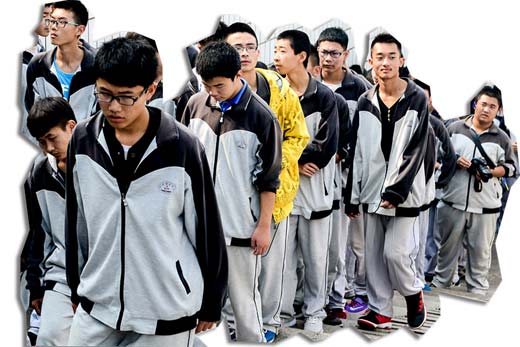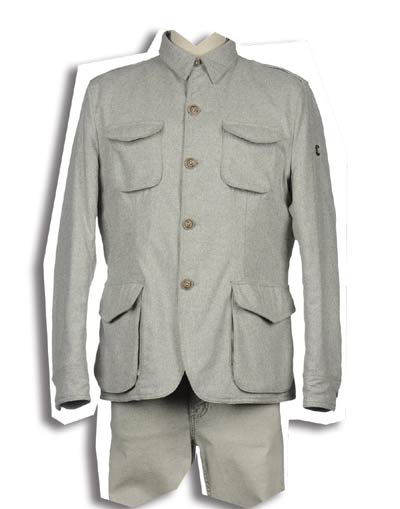當前位置: Language Tips> 雙語新聞
China's love affair with uniforms
分享到

Uniforms are a pervasive part of many societies. But in China there seems to be a particular adherence to uniforms. From entering the subway, passing security and stepping onto the train, you will have encountered not one, but multiple uniformed staff. Walking down the street will have meant dodging bright orange street cleaners, food-delivery staff on scooters or identically dressed salon workers receiving their morning briefing. Upon entering your office, you may have passed uniformed security guards on your way to colleagues dressed in suits and ties. They’re inescapable.
制服是許多社會普遍存在的一部分。但是中國人似乎更鐘情于制服。當你乘地鐵、過安檢和坐火車時,你都會看到穿著各種制服的工作人員。當你走在街上,隨處可以看到穿著明亮橘色制服的清潔工,騎著踏板車的送餐員以及接受早訓的沙龍服務員。當你去辦公室時,你會遇見穿著制服的保安,以及西裝革履的同事。制服無處不在。
The uniform's place in Chinese society can be traced back through the country’s history. As in most places across the world, they have been worn throughout the ages in the military to distinguish between factions and provide protection. Each dynasty favored a different style for its soldiers. Drawings of soldiers from the Eastern Zhou Dynasty (770-221 B.C.) show studded boots and uniforms with heavy arm and torso protection, whereas similar depictions from the Sui Dynasty (A.D. 581-618) illustrate draped and layered military wear. Uniforms were often as fierce as the battles their wearers fought in.
制服在中國社會的地位是有歷史可以追溯的。就像在世界其他地方一樣,士兵穿制服,一是為了區(qū)分軍事派別,二是為了提供保護。每一個朝代的士兵制服的風格都不同,從東周時期手繪士兵的畫像可以看出,他們穿著沉重的靴子和制服以保護手臂和身體,同樣的,從隋朝時期士兵的畫像可以看出,他們都披著一層一層的盔甲。制服常常是士兵在激烈戰(zhàn)斗中最好的保護。
Uniforms were also designed to show status and mark levels of authority. In China, the Terracotta Warriors in Xi’an were molded to wear styles commonly found in the Qin Dynasty (221-207 B.C.). Officers' ranks were discernible by their dress, with generals wearing a dual long jacket, long pants, thigh protectors, a crest hat and a pair of boots with square tips.
制服也通常用來顯示權威者的地位和階級。在中國,西安兵馬俑的穿著常見于秦朝。通過他們的穿著,可以明顯地分辨出軍官的軍銜,例如,將軍都是穿著兩層長袍,長褲子,一雙長方靴和帶著一頂帽子。

But at points throughout history, uniforms were deemed fashion items too. Zhongshan suits (Chinese tunic suits, above) were hugely popular among males in 1950s, with women’s clothing based on a similar style. Introduced by Sun Yat-Sen and made famous by Mao Zedong who favored it in public, hence the nickname ‘Mao suit’, the clothing became a form of national dress.
然而在歷史上,制服也曾是時尚物品。中山裝(如上圖所示)在20世紀50年代非常受歡迎,甚至女性的服裝也是類似的風格。中山裝是由孫中山發(fā)明的,由于毛澤東非常喜歡在公共場合穿,因此中山裝又稱“毛裝”。自此中山裝成為了一種民族服飾。
In the military, clothing now follows the generic western style of pants, jacket and a hat. The Zhongshan suit has also undergone modernization. With an altered shape and more streamlined look, the once shapeless garment is now fitted and more flattering for the male body. But while it is still a popular choice for Chinese leaders during important events, tunic suits are rarely seen in wider society.
軍事上,服裝一般都是遵循西式的風格,長褲、夾克以及帽子。原本沒什么型的中山裝也經歷了現(xiàn)代化,款式上有了改變,更流線型的外觀、更合體的剪裁凸顯出男性的身材美。盡管在重要場合,中山裝仍是中國領導人的首要選擇,但是在社會日常生活中很少見。
Yet, there are many places where uniforms live on. This is the case in the hospitality industry in particular, explains Catalina Calin, director of Calin Fashion Academy in Beijing.
北京Calin時裝學院校長Catalina Calin稱,仍然有很多地方需要制服,尤其是服務業(yè)。
“In Europe, you don’t see uniforms that often [compared to China]. Hospitality is the one industry that is still using them because they can project the type of service or professionalism that you are expecting,” she says. “A uniform is very important for how a client sees you, but it’s also important for how the employee is feeling. The uniform has to be fitted right for the person to feel confident and beautiful.”
“與中國相比,歐洲穿制服的人不那么常見。從事服務業(yè)的人仍然穿制服,因為這可以投射出你所期望的服務和專業(yè)”,她還說,“制服是客戶如何看待你的一個標準,但員工的感覺也很重要,合身的制服穿在身上能夠展現(xiàn)自信和美麗”。
Calin believes there will be more emphasis on uniforms’ appearance in the future: “Chinese ladies are starting to become more conscious of their appearance and beauty. This flows through to the places they work, which have to fit their needs,” she says, citing staff the New World Hotel’s Yin on 12 bar as an example of progression. “They wear short black skirts, rock-style shoes and dark make-up. This brings a very cool image to the bar.”
Calin認為,未來將會更加重視制服的外觀,她說“中國女性越來越在意自己的外表。她們工作的地方也需滿足她們的這一需求”。以New World Hotel酒吧的員工為例,“她們穿黑色短裙,搖滾風的鞋子,畫著煙熏妝,這帶給人一種非常酷的印象”。
But China’s love affair with uniforms stretches far beyond hospitality. While there is no single explanation for this, it may reflect a more inherently collectivist culture, where self-identity is shaped by group memberships. In the workplace, or in schools, people feel a stronger sense of self if they are able to define themselves as part of a group.
但是在中國,不僅僅是服務業(yè)鐘情于制服,雖然對此沒有單一的解釋,但是這可能反應了一種內在的集體文化,自我認同往往體現(xiàn)在集體關系中。在工作場所或者學校,如果能夠成為集體中的一部分,那么他們就有很強的自我認同感。
上一篇 : 那些改名換姓的名作(下)
下一篇 : 男性吃大蒜 體味更迷人
分享到
關于我們 | 聯(lián)系方式 | 招聘信息
電話:8610-84883645
傳真:8610-84883500
Email: languagetips@chinadaily.com.cn